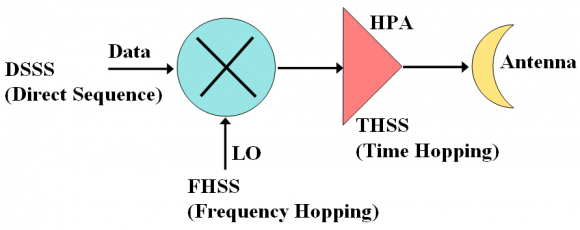If you wish to contribute or participate in the discussions about articles you are invited to contact the Editor
GNSS Modulation Schemes: Difference between revisions
Carlos.Lopez (talk | contribs) No edit summary |
Carlos.Lopez (talk | contribs) No edit summary |
||
| Line 1: | Line 1: | ||
{{Article Infobox2 | {{Article Infobox2 | ||
|Category=Fundamentals | |Category=Fundamentals | ||
|Authors=J.A Ávila Rodríguez, University FAF Munich, Germany. | |||
|Authors= J.A Ávila Rodríguez, University FAF Munich, Germany. | |||
|Level=Advanced | |Level=Advanced | ||
|YearOfPublication=2011 | |YearOfPublication=2011 | ||
|Title={{PAGENAME}} | |||
}} | }} | ||
Galileo and GPS signals are generated using the well-known Direct Sequence Spread Spectrum (DSSS) technique. DSSS is a particular case of Spread Spectrum (SS) technique. | Galileo and GPS signals are generated using the well-known Direct Sequence Spread Spectrum (DSSS) technique. DSSS is a particular case of Spread Spectrum (SS) technique. | ||
| Line 27: | Line 26: | ||
==References== | ==References== | ||
<references/> | <references/> | ||
== Credits == | |||
The information presented in this NAVIPEDIA’s article is an extract of the PhD work performed by Dr. Jose Ángel Ávila Rodríguez in the FAF University of Munich as part of his Doctoral Thesis “On Generalized Signal Waveforms for Satellite Navigation” presented in June 2008, Munich (Germany) | |||
Latest revision as of 09:10, 25 November 2011
| Fundamentals | |
|---|---|
| Title | GNSS Modulation Schemes |
| Author(s) | J.A Ávila Rodríguez, University FAF Munich, Germany. |
| Level | Advanced |
| Year of Publication | 2011 |
Galileo and GPS signals are generated using the well-known Direct Sequence Spread Spectrum (DSSS) technique. DSSS is a particular case of Spread Spectrum (SS) technique.
The SS principle seems simple and evident, but its implementation is indeed complex. In order to accomplish this objective, different SS techniques are available, but they all have one thing in common: they perform the spreading and dispreading operation by means of a pseudo random noise (PRN) code attached to the communication channel. The manner of inserting this code into the transmitting chain before the antenna is actually what defines the particular SS technique, as next figure shows:
According to this, a DSSS signal, s(t) can be represented as follows [C.J. Hegarty, 2003][1] and [C.J. Hegarty et al., 2005][2]:
where [math]\displaystyle{ \left \{ c_k \right \} }[/math] represents the pseudorandom code symbols (which may be periodic), p(t) is the chip waveform which is non-zero only over the interval support [math]\displaystyle{ [0,T_c) }[/math] refers to the chip period and N is the number of equal length divisions of one chip period. In the next chapters of this chapter we will study different waveforms and analyse them in terms of their spectral efficiency and characteristics.
Of all the possible chip waveforms, the binary solutions belong to the most interesting for satellite navigation. Nevertheless, technology progresses so fast that it is possible to imagine more complex non-binary alternative spreading waveforms in a near future. In this chapter we will discuss the possibilities and potential they could bring to the navigation world.
References
- ^ [C.J. Hegarty, 2003] C.J. Hegarty, Alternative Bi-phase GNSS Modulations, MITRE Memo F82-M04-004, 24 November 2003.
- ^ [C.J. Hegarty et al., 2005] C.J. Hegarty, J.W. Betz and A. Saidi, Binary Coded Symbol Modulations for GNSS, Proceedings of the National Technical Meeting of the Institute of Navigation, ION-NTM 2005, January 2005, San Diego, California, USA.
Credits
The information presented in this NAVIPEDIA’s article is an extract of the PhD work performed by Dr. Jose Ángel Ávila Rodríguez in the FAF University of Munich as part of his Doctoral Thesis “On Generalized Signal Waveforms for Satellite Navigation” presented in June 2008, Munich (Germany)


